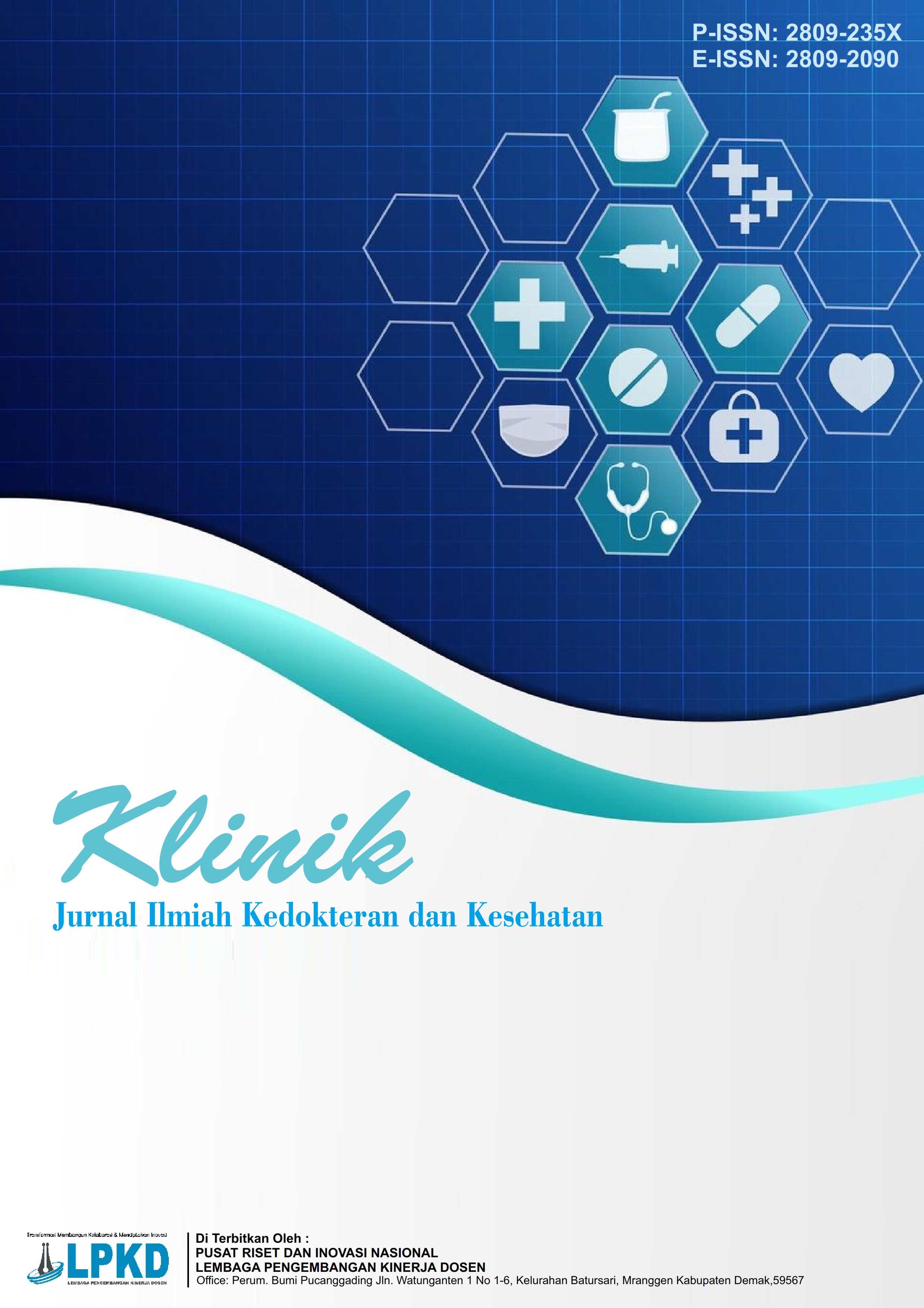Peran Malassezia spp. pada Dermatitis Seboroik: Literature Review
DOI:
https://doi.org/10.55606/klinik.v5i1.5664Keywords:
Malassezia spp, seborrheic dermatitis, dysbiosis, pathogenesis, Inflammatory ResponseAbstract
orrheic dermatitis (DS) is a chronic inflammatory skin disease that is commonly found in areas of the body rich in sebaceous glands, such as the scalp, central face, and upper chest. The disease is characterized by lesions that can be reddish plaques with oily scales, as well as itchy complaints. The etiology of DS is multifactorial, where in addition to genetic factors, environmental factors, and immunology also play an important role. One of the main factors in the pathogenesis of DS is infection by Malassezia spp., specifically M. globosa and M. restricta, which play a role in triggering an inflammatory response. This fungus, which is a normal flora on human skin, can transform into opportunistic pathogens under certain conditions, such as microbiota dysbiosis, increased sebum production, or disorders in the skin barrier. Malassezia's metabolic activities, such as oleic acid production, can impair the integrity of the epidermis and lead to the hyperproliferation of keratinocytes. In addition, activation of pattern-recognition receptors in immune cells triggers the inflammatory pathway IL-23/IL-17, which worsens inflammatory conditions in the skin. A deep understanding of the role of Malassezia spp. in the pathogenesis of DS is essential for determining accurate diagnosis and the development of more effective management, including the use of targeted antifungal therapies.
References
Adalsteinsson, J. A., Kaushik, S., & Ferris, L. K. (2020). Advances in understanding seborrheic dermatitis: The role of Malassezia yeasts. Experimental Dermatology, 29(5), 481–489. https://doi.org/10.1111/exd.14102
Bolognia, J. L., Schaffer, J. V., & Cerroni, L. (2019). Dermatology (4th ed.). Elsevier.
Clark, G. W., & Elewski, B. E. (2022). Seborrheic dermatitis: An overview of pathogenesis and management. In Fitzpatrick’s Dermatology (9th ed.). McGraw-Hill.
Dawson, T. L. (2020). Malassezia and seborrheic dermatitis: Insights into pathogenesis. Journal of Cosmetic Science, 71(5), 283–294.
Gupta, A. K., Madzia, R., & Shear, N. H. (2023). Seborrheic dermatitis: An update on etiology, pathogenesis, and treatment. Journal of the European Academy of Dermatology and Venereology, 37(6), 1104–1111. https://doi.org/10.1111/jdv.19087
Jia, Q., Zhao, J., & Xu, Y. (2024). Malassezia-induced Th17 responses and their role in chronic skin inflammation. Mycopathologia, 189(1), 85–97. https://doi.org/10.1007/s11046-023-00832-1
Li, H., Zhang, Y., & Wang, X. (2022). Morphological and molecular identification of Malassezia species in human skin diseases. Medical Mycology, 60(7), myac047. https://doi.org/10.1093/mmy/myac047
Park, H. R., Kim, J. Y., & Lee, Y. W. (2021). Pattern recognition receptors and Malassezia in seborrheic dermatitis: Current perspectives. Mycoses, 64(3), 292–299. https://doi.org/10.1111/myc.13215
Rallis, E., Katoulis, A. C., & Rigopoulos, D. (2021). Seborrheic dermatitis: An update on pathogenesis and therapeutic options. Dermatology and Therapy, 11(1), 15–27. https://doi.org/10.1007/s13555-020-00455-5
Rousel, E., de Maleissye, M. F., & Battistella, M. (2024). Skin barrier dysfunction in seborrheic dermatitis: Current understanding and future perspectives. Clinical and Experimental Dermatology, 49(2), 197–204. https://doi.org/10.1111/ced.16890
Ruchti, F., Sparber, F., & LeibundGut-Landmann, S. (2024). γδ T cells and Malassezia-specific immune responses in human skin. Frontiers in Immunology, 15, 1334–1342. https://doi.org/10.3389/fimmu.2024.12945
Sasseville, D., Bolduc, C., & Jfri, A. (2020). Seborrheic dermatitis: Clinical features and immunologic insights. In Fitzpatrick’s Dermatology in General Medicine (9th ed.). McGraw-Hill.
Saunders, C. W., Scheynius, A., & Heitman, J. (2020). Malassezia fungi influence cutaneous health and disease. Nature Reviews Microbiology, 18(10), 554–565. https://doi.org/10.1038/s41579-020-0374-9
Sparber, F., Ruchti, F., & LeibundGut-Landmann, S. (2019). Host responses to Malassezia spp. in the skin: Insights into immunopathology. Seminars in Immunopathology, 41(5), 579–594. https://doi.org/10.1007/s00281-019-00758-8
Sudarmanto, S. H., Nugraha, D., & Arifin, R. (2024). Peran Malassezia spp. dalam patogenesis dermatitis seboroik. Medula, 14(11), 2133–2139. https://doi.org/10.33475/medula.v14i11.2133
Xu, J., Saunders, C. W., & Lian, W. (2021). Genomic and metabolic adaptations of Malassezia to lipid-dependent lifestyles. Fungal Genetics and Biology, 146, 103501. https://doi.org/10.1016/j.fgb.2020.103501
Yamada, T., & Kimura, T. (2023). Interplay between microbiome dysbiosis and sebaceous gland activity in seborrheic dermatitis. Frontiers in Cellular and Infection Microbiology, 13, 117–129. https://doi.org/10.3389/fcimb.2023.12194
Zhao, R., Wang, J., & Liu, Q. (2020). Lipid metabolism and its role in the pathogenesis of seborrheic dermatitis. International Journal of Molecular Sciences, 21(22), 8561. https://doi.org/10.3390/ijms21228561
Zhu, Y., Han, L., & Chen, Q. (2022). Sebum composition changes and skin microbiome interactions in seborrheic dermatitis. Scientific Reports, 12(1), 11721. https://doi.org/10.1038/s41598-022-11721-x
Downloads
Published
How to Cite
Issue
Section
License
Copyright (c) 2025 Jurnal Ilmiah Kedokteran dan Kesehatan

This work is licensed under a Creative Commons Attribution-ShareAlike 4.0 International License.








